relevant Publications
Find here relevant scientific publications and technical articles – including from TherVacB project partners. Scroll down to read more about chronic hepatitis B, the virus, screening and testing for viral hepatitis C, B and D, therapeutic vaccination, and cure research as welll as ethical and practical considerations of patient recruitment into clinical trials.
Perceptions of stigma among patients with hepatitis B in Germany: Cross-sectional survey
13 June 2025 | JMIR Human Factors, Volume 9 (2025)
The key question discussed in this scientific publication is: How do people in Germany experience stigma related to hepatitis B? Most interdisciplinary research on hepatitis B stigma comes from outside Europe. To address this gap, TherVacB team at the Institute of History and Ethics in Medicine at TUM-MRI (Munich, Germany) conducted a study with 195 patients across Germany, supported by TherVacB clinical centres in Munich, Hannover, and Leipzig. The findings show that individuals who speak a language other than German, place a high value on privacy, or keep their diagnosis secret are more likely to feel stigmatized. In contrast, age, gender, and education had no influence on perceived stigma. While stigma levels were generally lower than in studies from Asia, cultural and social factors still play a key role. These results from TherVacB underline the need to raise awareness among healthcare professionals and support targeted community outreach.
Scientific and medical evidence informing expansion of hepatitis B treatment guidelines
23 July 2025 | The Lancet Gastroenterology & Hepatology
This scientific article explores whether current treatment guidelines for hepatitis B are too narrow—and whether more people could benefit from antiviral therapy. Today’s treatments can suppress the virus and protect the liver, but they do not offer a cure. Global guidelines typically recommend treatment only for people with high viral load and signs of liver damage—criteria that often require testing not widely available in low-resource settings. As a result, fewer than 3% of people living with hepatitis B currently receive treatment. This article discusses the risks and benefits of expanding treatment eligibility, highlighting the potential for earlier and broader intervention to reduce long-term liver damage and cancer risk. TherVacB researchers Markus Cornberg and Patrick Kennedy, together with Thomas Tu (ICE-HBV) and others, contributed to this important publication, which supports global hepatitis B elimination goals by promoting more inclusive treatment strategies.
https://www.thelancet.com/journals/langas/article/PIIS2468-1253(25)00053-6/abstract
Patient and public health perspectives to inform expansion of hepatitis B treatment guidelines
23 July 2025 | The Lancet Gastroenterology & Hepatology
This scientific article discusses the need to broaden access to hepatitis B treatment as part of a global public health strategy. Expanding treatment could improve lives and support progress toward hepatitis B elimination. Chronic infection affects millions worldwide and has serious physical, emotional, and social impacts. While antiviral therapy can prevent liver damage and improve quality of life, access remains limited—especially in low-resource settings. The authors argue that treatment decisions should consider public health and patient-centred perspectives, not just clinical criteria. They highlight the benefits of earlier access, including reduced disease burden and better outcomes, and outline implementation challenges and data gaps. The publication was led by an international team of researchers from the Hepatitis B Foundation, ICE-HBV, the World Hepatitis Alliance, and academic centres in the US, UK, Australia, Egypt, and Europe. Together, they call for a more inclusive approach to treatment that supports global hepatitis B elimination goals.
https://www.sciencedirect.com/science/article/abs/pii/S2468125325000524?dgcid=author
EASL Clinical Practice Guidelines on the management of hepatitis B virus infect
August 2025, first published online 9 May 2025 | Journal of Hepatology, Volume 83
Updated clinical guideline supports better care for hepatitis B worldwide: Hepatitis B remains a major global health challenge, with over 250 million people affected and many at risk of serious liver disease. The newly updated clinical practice guideline from the European Association for the Study of the Liver (EASL) provides practical, evidence-based recommendations to improve diagnosis, treatment, and long-term care. It is designed for all healthcare professionals involved in HBV care, from general practitioners to specialists, and includes specific guidance for both high- and low-resource settings. The guideline highlights the importance of early detection, personalised care, simplified treatment approaches, and new definitions of functional cure. TherVacB team researchers Markus Cornberg (Chair of the EASL Clinical Practice Guideline Panel), Patrick Kennedy, and Sabela Lens contributed – with other scientists – in developing this important tool, which supports the global goal of hepatitis B elimination.
https://www.journal-of-hepatology.eu/article/S0168-8278(25)00174-6/fulltext?s=35

Social Media Recruitment as a Potential Trigger for Vulnerability: Multistakeholder Interview Study
30 December 2024 | JMIR Human Factors, Volume 11
Clinical studies increasingly use social media to recruit participants, yet little research has examined the ethical challenges—especially when targeting individuals in vulnerable situations. This study explores expert and patient perspectives on how social media recruitment can both reduce and amplify vulnerabilities. As part of the international TherVacB EU research project testing a hepatitis B vaccine, the authors conducted 30 interviews with external experts from various fields and 6 patients with hepatitis B. Insights from the study offer practical guidance for minimizing risks while maintaining the benefits of social media recruitment. The study highlights the need for researchers to anticipate ethical challenges and proactively apply strategies that promote both inclusivity and participant protection.

The urgent need to end hepatitis B stigma and discrimination
17 December 2024 / 10 January 2025 | The Lancet Gastroenterology & Hepatology, Volume 10
In this article, authors call for prioritization to end hepatitis B-related discrimination, taking into account the WHO global hepatitis report 2024.
https://www.thelancet.com/journals/langas/article/PIIS2468-1253(24)00389-3/abstract

A cancer-causing virus hiding in millions of Americans. Why does hepatitis B, which can lead to liver cancer, often go undetected, even though tests exist?
18 December 2024 | The New Yorker
The major U.S. popular media magazine The New Yorker prioritizes hepatitis B and its health disparities in the USA. Hepatitis B Foundation President Dr. Chari Cohen is quoted in a powerful new story about hepatitis B.

Acceptance of Social Media Recruitment for Clinical Studies Among Patients With Hepatitis B: Mixed Methods Study
This study focuses on patients with hepatitis B in Germany and examines their attitudes toward using social media platforms like Facebook and Twitter for recruiting participants into clinical trials. Hepatitis B is a chronic infectious disease, and patients with this condition are often seen as vulnerable, facing potential stigma and discrimination. Researchers at TherVacB’s TUM-MED and at TUM, University of Bern and University of Basel surveyed 195 patients from three clinical centres in Germany and found that factors like digital literacy, trust in nonmedical sources, privacy concerns, and willingness to share their diagnosis impact their acceptance of social media recruitment. The study emphasizes how understanding these factors, including health technology acceptance, can help researchers design recruitment strategies while balancing ethics and data protection considerations, especially in this vulnerable group. These insights could improve enrolment for clinical studies in the future.
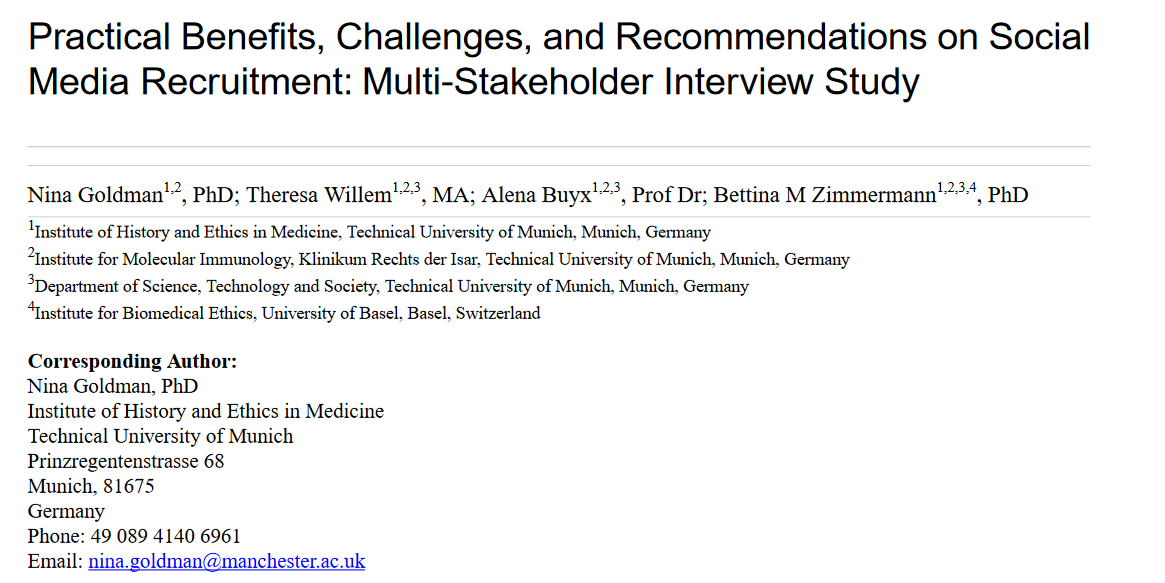
Practical Benefits, Challenges, and Recommendations on Social Media Recruitment: Multi-Stakeholder Interview Study
The increasing use of social media opens new opportunities for recruiting patients for research studies. Based on semi-structured interviews with both people using social media and living with hepatitis B as well as experts in a range of disciplines, authors are exploring the practical benefits of recruiting study participants with social media and are sharing an expert summary on how to conduct social media-based recruitment. Generally, a multiplatform approach with mixed-methods recruitment is the most beneficial recruitment strategy for many research studies. The different recruitment methods complement each other and may contribute to improving the reach of the study, the recruitment accrual, and the representativeness of the sample. Importantly, an assessment of the context- and project-specific appropriateness and usefulness of social media recruitment should be carried out before designing the recruitment strategy.
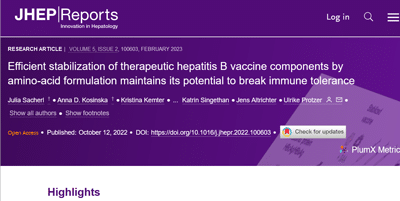
Efficient stabilization of therapeutic hepatitis B vaccine components by amino-acid formulation maintains its potential to break immune tolerance
February 2023 | Journal of Hepatology
Induction of potent, HBV-specific immune responses is crucial to control and finally cure HBV. The therapeutic hepatitis B vaccine TherVacB combines protein priming with a Modified Vaccinia virus Ankara (MVA)-vector boost to break immune tolerance in chronic HBV infection. Particulate protein and vector vaccine components, however, require a constant cooling chain for storage and transport, posing logistic and financial challenges to vaccine applications. Authors of this article aimed to identify an optimal formulation to maintain stability and immunogenicity of the protein and vector components of the vaccine using a systematic approach. This will facilitate global vaccine application without the need for cooling chains and is important for the development of prophylactic as well as therapeutic vaccines supporting vaccination campaigns worldwide.
https://www.jhep-reports.eu/article/S2589-5559%2822%2900175-6/fulltext
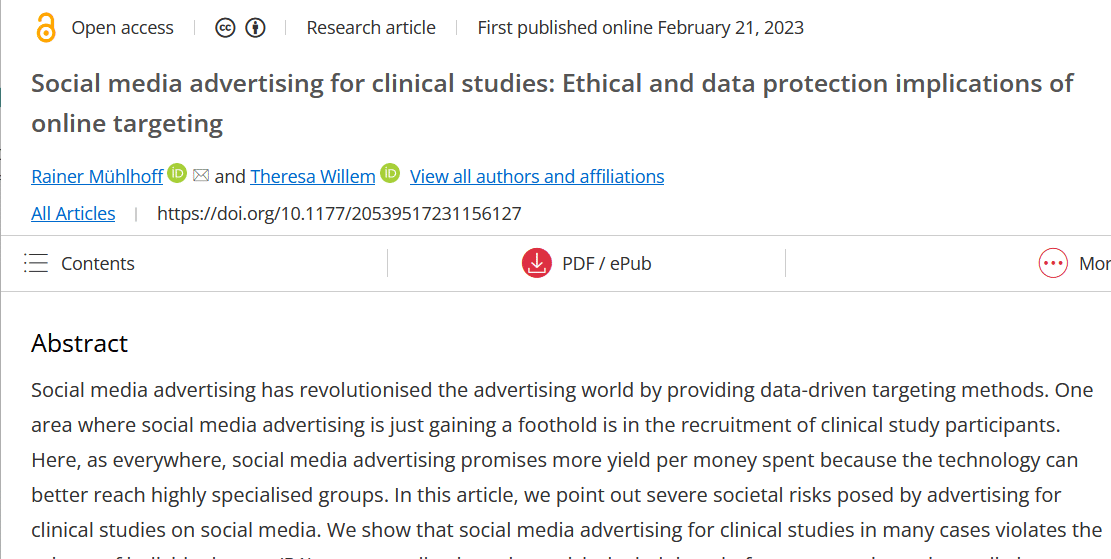
Social media advertising for clinical studies: Ethical and data protection implications of online targeting
21 February 2023 | Big Data & Society
Social media advertising is gaining a foothold in the recruitment of clinical study participants, promising more yield per money spent because the technology can better reach highly specialised groups. In this article, authors point out severe societal risks posed by advertising for clinical studies on social media and call for updates of research ethics guidelines and better regulation of Big Data and inferential analytics. In conclusion, social media advertising – especially with vulnerable patient populations – is deemed unsuitable as a recruitment tool for clinical studies as long as the processing of (even anonymised) social media usage data and the training of predictive models by data analytics and artificial intelligence companies is not sufficiently regulated.
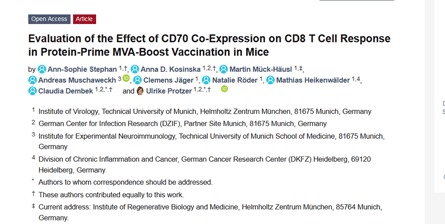
Evaluation of the Effect of CD70 Co-Expression on CD8 T Cell Response in Protein-Prime MVA-Boost Vaccination in Mice
This article investigates the potential of CD70 co-expression during viral vector boost vaccination to improve an antigen-specific T cell response. In sum, the article presents a safe system to selectively enhance the vector-vaccine-induced CD8 T cell response to the target antigen through CD70 co-expression during boost immunization. In this respect, this study may contribute to the development and improvement of therapeutic vaccines revealing novel generic design principles and thus foster advances of current strategies to fight malignancies and persistent viral infections.
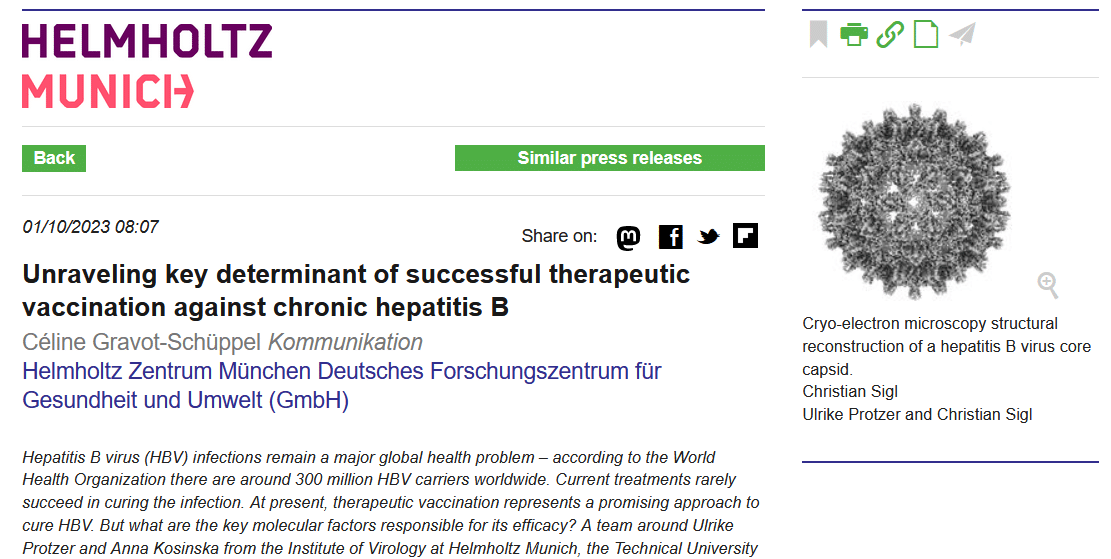
Activation of CD4 T cells during prime immunization determines the success of a therapeutic hepatitis B vaccine in HBV-carrier mouse models
9 January 2023 | Journal of Hepatology
Authors describe the recently developed a heterologous therapeutic vaccination scheme (TherVacB) comprising a particulate protein prime followed by a modified vaccinia-virus Ankara (MVA)-vector boost for the treatment of HBV. However, the key determinants required to overcome HBV-specific immune tolerance remain unclear. In this article, new combination adjuvants and unravel factors are studied that are essential for the antiviral efficacy of the TherVacB vaccination scheme.
Read more about the work by the team around Prof. Dr. Ulrike Protzer and Dr. Anna Kosinska here: https://idw-online.de/en/news807417
https://www.journal-of-hepatology.eu/article/S0168-8278(22)03465-1/fulltext#secsectitle0045
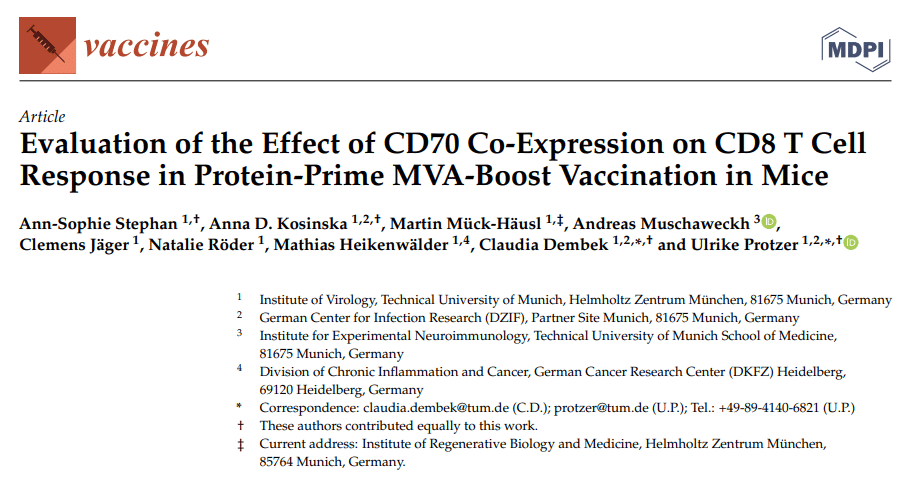
Evaluation of the Effect of CD70 Co-Expression on CD8 T Cell Response in Protein-Prime MVA-Boost Vaccination in Mice
21 January 2023 | Vaccines – Special Issue Hepatitis Virus Vaccine Immune Therapy
In this article, the team of researchers investigates the potential of CD70 co-expression during viral vector boost vaccination to improve an antigen-specific T cell response. Overall, this study indicates that orchestrated co-expression of CD70 and a vaccine antigen may be an interesting and safe means of enhancing antigen-specific CD8 T cell responses using vector-based vaccines, although in our study it was not sufficient to break immune tolerance.
https://www.mdpi.com/2076-393X/11/2/245
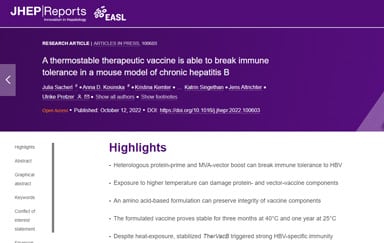
A thermostable therapeutic vaccine is able to break immune tolerance in a mouse model of chronic hepatitis B
12 October 2022 | Journal of Hepatology (JHEP) Reports
Therapeutic vaccination is a promising therapeutic option for chronic hepatitis B that may allow to cure chronic hepatitis B. However, its application requires functional cooling chains during transport and storage that can hardly be guaranteed in many countries with high demand. In this study, the authors including Julia Sacherl, Anna D. Kosinska and Ulrike Protzer, developed thermostable vaccine components that are well tolerated and allow inducing immune responses and control the virus in preclinical mouse models even after long-term exposure to high surrounding temperatures. This will lower costs and ease application of a therapeutic vaccine and thus be beneficial for the many hepatitis B patients worldwide.
Read more about the work by the team at Prof. Protzer’s lab here: https://www.dzif.de/en/chronic-hepatitis-b-development-thermostable-therapeutic-vaccine.
https://www.jhep-reports.eu/article/S2589-5559(22)00175-6/fulltext
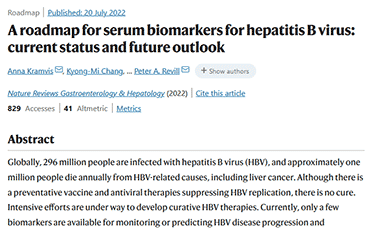
A roadmap for serum biomarkers for hepatitis B virus: current status and future outlook
Globally, 296 million people are infected with hepatitis B virus (HBV), and approximately one million people die annually from HBV-related causes. Although there is a preventative vaccine and antiviral therapies suppressing HBV replication, there is no cure. Intensive efforts are under way to develop curative HBV therapies. Currently, only a few biomarkers are available for monitoring or predicting HBV disease progression and treatment response. As new therapies become available, new biomarkers to monitor viral and host responses are urgently needed. In October 2020, the International Coalition to Eliminate Hepatitis B Virus (ICE-HBV) held a workshop on HBV biomarkers. Various stakeholders from academia, clinical practice, and the pharmaceutical industry, with complementary expertise, presented and participated in panel discussions – including Ulrike Protzer, Mala Maini, and Florian van Bömmel. This Roadmap summarizes the strengths, weaknesses, opportunities, and challenges of HBV biomarkers.
https://www.nature.com/articles/s41575-022-00649-z
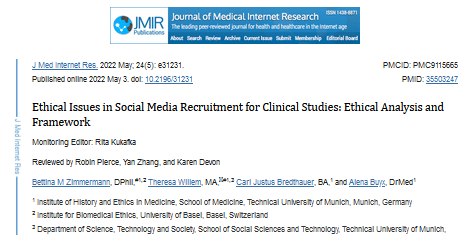
Ethical Issues in Social Media Recruitment for Clinical Studies: Ethical Analysis and Framework
Bettina M Zimmermann, Theresa Willem, Carl Justus Bredthauer, Alena Buyx
Social media recruitment for clinical studies holds the promise of being a cost-effective way of attracting traditionally marginalized populations and promoting patient engagement with researchers and a particular study. However, using social media for recruiting clinical study participants also poses a range of ethical issues. The study summarized in this paper aims to provide a comprehensive overview of the ethical benefits and risks to be considered for social media recruitment in clinical studies and develop practical recommendations on how to implement these considerations.
https://www.ncbi.nlm.nih.gov/pmc/articles/PMC9115665/
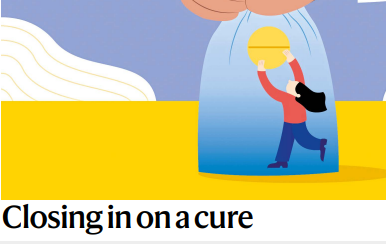
Closing in on a cure for hepatitis B
30 March 2022 | Nature
Elie Dolgin
Finite courses of treatment could get the virus under control — with the right combination of drugs.
Read on to know more how TherVacB’s Ulrike Protzer and Mala Maini together with other leading HBV scientists, virologists, viral immunologists and hepatologists around the world have pushed the development of an HBV cure-focused action plan that includes patient perspectives.
https://www.nature.com/articles/d41586-022-00812-1
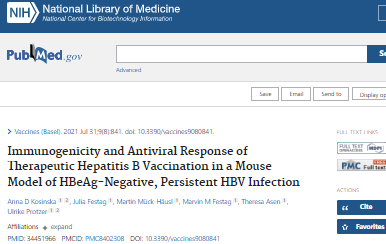
Immunogenicity and Antiviral Response of Therapeutic Hepatitis B Vaccination in a Mouse Model of HBeAg-Negative, Persistent HBV Infection
31 July 2021 | Vaccines
Anna D Kosinska, Julia Festag, Martin Mück-Häusl, Marvin M Festag, Theresa Asen, Ulrike Protzer
During the natural course of chronic hepatitis B virus (HBV) infection, the hepatitis B e antigen (HBeAg) is typically lost, while the direct transmission of HBeAg-negative HBV may result in fulminant hepatitis B. While the induction of HBV-specific immune responses by therapeutic vaccination is a promising, novel treatment option for chronic hepatitis B, it remains unclear whether a loss of HBeAg may influence its efficacy or tolerability. We therefore generated an adeno-associated virus (AAV)-vector that carries a 1.3-fold overlength HBV genome with a typical stop-codon mutation in the pre-core region and initiates the replication of HBeAg(-) HBV in mouse livers. Infection of C57BL/6 mice established persistent HBeAg(-) HBV-replication without any detectable anti-HBV immunity or liver damage. HBV-carrier mice were immunized with TherVacB, a therapeutic hepatitis B vaccine that uses a particulate HBV S and a core protein for prime vaccination, and a modified vaccinia Ankara (MVA) for boost vaccination. The TherVacB immunization of HBeAg(+) and HBeAg(-) HBV carrier mice resulted in the effective induction of HBV-specific antibodies and the loss of HBsAg but only mild liver damage. Intrahepatic, HBV-specific CD8 T cells induced in HBeAg(-) mice expressed more IFNγ but showed similar cytolytic activity. This indicates that the loss of HBeAg improves the performance of therapeutic vaccination by enhancing non-cytolytic effector functions.
https://pubmed.ncbi.nlm.nih.gov/34451966/
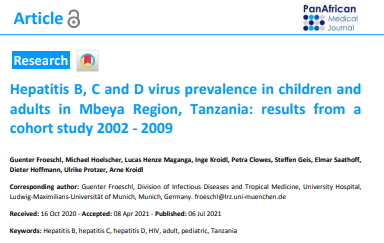
Hepatitis B, C and D virus prevalence in children and adults in Mbeya Region, Tanzania: results from a cohort study 2002 - 2009
6 July 2021 | The Pan African Medical Journal
Guenter Froeschl, Michael Hoelscher, Lucas Henze Maganga, Inge Kroidl, Petra Clowes, Steffen Geis, Elmar Saathoff, Dieter Hoffmann, Ulrike Protzer, Arne Kroidl
Sub-Saharan Africa bears a high prevalence for hepatitis B virus (HBV) infection. This analysis aims at elucidating the exposure to HBV across different age groups in Mbeya Region in Tanzania and determines prevalence of hepatitis C (HCV) and hepatitis delta antigen (HDV) infections.
https://www.panafrican-med-journal.com/content/article/39/174/full/

Screening auf Hepatitis B und C gehört jetzt zur Gesundheitsvorsorge
17 June 2021 | Der Hausarzt.DIGITAL
Ulrike Protzer
Kürzlich wurden Tests auf Hepatitis B und C in die Gesundheitsvorsorge (“Check-up”) aufgenommen. Versicherte ab 35 Jahren können sich einmalig auf diese beiden Erkrankungen untersuchen lassen. Dr. med. Ulrich Scharmer sprach darüber mit der Virologin Prof. Dr. med. Ulrike Protzer, München.
https://www.hausarzt.digital/medizin/praevention/screening-auf-hepatitis-b-und-c-gehoert-jetzt-zur-gesundheitsvorsorge-95051.html
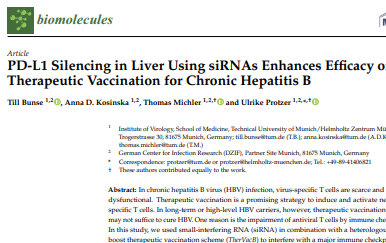
PD-L1 Silencing in Liver Using siRNAs Enhances Efficacy of Therapeutic Vaccination for Chronic Hepatitis B
18 March 2021 | Biomolecules
Till Bunse, Anna D. Kosinska, Thomas Michler and Ulrike Protzer
In chronic hepatitis B virus (HBV) infection, virus-specific T cells are scarce and partially dysfunctional. Therapeutic vaccination is a promising strategy to induce and activate new virus-specific T cells. In long-term or high-level HBV carriers, however, therapeutic vaccination by itself may not suffice to cure HBV. One reason is the impairment of antiviral T cells by immune checkpoints. In this study, we used small-interfering RNA (siRNA) in combination with a heterologous prime-boost therapeutic vaccination scheme (TherVacB) to interfere with a major immune checkpoint, the interaction of programmed death protein-1 (PD-1) and its ligand (PDL-1). In mice persistently replicating HBV after infection with an adeno-associated virus harboring the HBV genome, siRNA targeting PD-L1 resulted in a higher functionality of HBV-specific CD8+ T cells after therapeutic vaccination, and allowed for a more sustained antiviral effect and control of HBV in peripheral blood and in the liver. The antiviral effect was more pronounced if PD-L1 was down-regulated during prime than during boost vaccination. Thus, targeting PD-L1 using siRNA is a promising approach to enhance the efficacy of therapeutic vaccination and finally cure HBV.
https://www.mdpi.com/2218-273X/12/3/470
